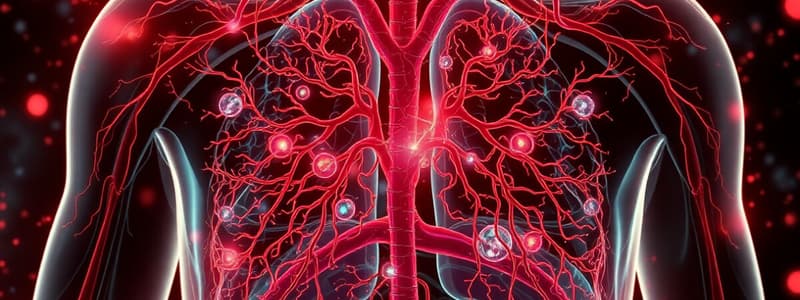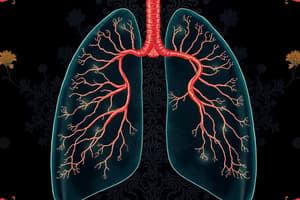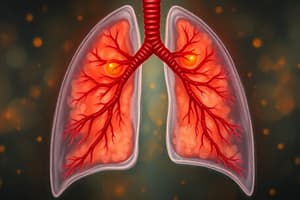Podcast
Questions and Answers
What is the primary distinction between an open and a closed circulatory system?
What is the primary distinction between an open and a closed circulatory system?
- Open circulatory systems do not have a heart.
- Closed circulatory systems rely on tracheae for oxygen transport.
- Closed circulatory systems use hemolymph as their fluid.
- Open circulatory systems do not distinguish between circulating fluid and extracellular fluid. (correct)
During gas exchange, which of the following describes the role of diffusion at the respiratory surface?
During gas exchange, which of the following describes the role of diffusion at the respiratory surface?
- O2 moves from air or water into blood. (correct)
- O2 moves from blood into air or water.
- CO2 moves from tissues into lungs.
- CO2 moves from air into blood.
What is the main function of alveoli in mammal lungs?
What is the main function of alveoli in mammal lungs?
- To increase the surface area for gas exchange. (correct)
- To transport blood away from the heart.
- To filter carbon dioxide out of the lungs.
- To facilitate ventilation through tracheae.
What occurs during exhalation?
What occurs during exhalation?
Which characteristic accurately describes capillaries in the circulatory system?
Which characteristic accurately describes capillaries in the circulatory system?
What is the primary function of dendrites in a neuron?
What is the primary function of dendrites in a neuron?
What happens to Na+ and K+ ions during an action potential?
What happens to Na+ and K+ ions during an action potential?
Which nervous system is responsible for promoting rest and digest functions?
Which nervous system is responsible for promoting rest and digest functions?
Which part of the ear is responsible for transforming vibrations into hearing and balance?
Which part of the ear is responsible for transforming vibrations into hearing and balance?
What is the function of the iris in the eye?
What is the function of the iris in the eye?
Which type of muscle is responsible for pumping blood throughout the body?
Which type of muscle is responsible for pumping blood throughout the body?
Which type of skeletal system utilizes a rigid structure on the outside of the body?
Which type of skeletal system utilizes a rigid structure on the outside of the body?
What type of sensory receptor detects changes in temperature?
What type of sensory receptor detects changes in temperature?
Flashcards
Hemolymph
Hemolymph
Fluid in open circulatory systems where there's no distinction between circulating and extracellular fluid.
Ventilation
Ventilation
Movement of air or water through lungs or gills.
Bronchi
Bronchi
Narrow tubes branching from the trachea that carry air into the lungs.
Bronchioles
Bronchioles
Signup and view all the flashcards
Inhalation
Inhalation
Signup and view all the flashcards
Exhalation
Exhalation
Signup and view all the flashcards
Arteries
Arteries
Signup and view all the flashcards
Capillaries
Capillaries
Signup and view all the flashcards
Drug Abuse
Drug Abuse
Signup and view all the flashcards
Cornea
Cornea
Signup and view all the flashcards
Iris
Iris
Signup and view all the flashcards
Mechanoreceptors
Mechanoreceptors
Signup and view all the flashcards
Sarcomere
Sarcomere
Signup and view all the flashcards
Study Notes
Open vs Closed Circulatory Systems
- Open: No distinction between circulating and extracellular fluid. This fluid is called hemolymph. The heart pumps hemolymph, but tissues like wing muscles receive oxygen directly from tracheae.
- Closed: Distinct circulatory fluid enclosed in blood vessels and transported to and from the heart. The heart pumps blood to arteries which carry blood away from the heart. Arteries branch into capillaries where gas exchange occurs. Veins return blood to the heart.
Oxygen & Carbon Dioxide
- Gas Exchange: Consists of 5 major steps:
- Ventilation: Movement of air or water through a specialized organ like lungs or gills.
- Diffusion at respiratory surface: Oxygen moves from air/water into blood and CO2 moves from blood into air/water.
- Circulation: Transporting dissolved oxygen and CO2 throughout the body via the circulatory system.
- Diffusion at tissue: Oxygen moves from blood into tissue and CO2 moves from tissue into blood.
- Cellular respiration: Cells use oxygen and produce carbon dioxide.
Bronchi vs. Bronchioles
- Bronchi: Narrow tubes that carry inhaled air to the lungs, branching off from the trachea.
- Bronchioles: Even narrower tubes that branch off from the bronchi within the lungs.
Alveoli
- Tiny sacs within mammal lungs that greatly increase surface area for gas exchange.
Inhalation & Exhalation
- Inhalation: Diaphragm contracts, moving down and lowering pressure in the chest cavity. This causes lungs to expand and air to move in.
- Exhalation: Diaphragm relaxes, chest cavity decreases (ribs relax), and air is exhaled.
Types of Blood Vessels
- Arteries: Tough, thick-walled vessels that carry blood away from the heart under high pressure.
- Capillaries: Vessels with walls only one cell thick, allowing gas exchange between blood and tissues. Form capillary beds.
- Veins: Thin-walled vessels that return blood to the heart.
Anatomy of a Neuron
- Dendrite: Receives chemical signals and converts them into electrical signals.
- Axon: Conducts electrical signals.
- Cell Body: Integrates incoming electrical signals.
Action Potential
- Involves the transport of sodium (Na+) ions outside the axon and potassium (K+) ions inside.
Parasympathetic vs. Sympathetic Nervous Systems
- Parasympathetic: Promotes "rest and digest" functions that conserve or restore energy.
- Sympathetic: Prepares organs for stressful situations ( "fight-or-flight")
Human Brain
- Drug abuse: Can disrupt brain function and have long-term consequences.
Function of the Ear
- Inner Ear: Transforms vibrations for hearing and balance.
- Middle Ear: Transmits sound waves from the external environment to the inner ear.
- Outer Ear: Collects pressure waves and funnels them into the ear canal where they strike the tympanic membrane.
Eye Parts
- Cornea: Transparent sheet of connective tissue that helps focus light.
- Iris: Pigmented round muscle inside the cornea that controls the size of the pupil.
- Pupil: Hole in the center of the iris that allows light to enter the eye.
- Lens: Clear, curved structure that focuses incoming light onto the retina.
- Retina: Back of the eye where the cornea and lens focus light.
Lateral Line System
- Series of canals running along the head and body of fish. Water enters the canals through pores and bends kinocilia on hair cells which activate sensory neurons, helping fish detect water movement and vibrations.
Types of Sensory Receptors
- Mechanoreceptors: Respond to distortion caused by pressure.
- Photoreceptors: Respond to particular wavelengths of light.
- Chemoreceptors: Detect specific molecules.
- Thermoreceptors: Detect changes in temperature.
- Nociceptors: Sense harmful stimuli such as tissue injury.
- Electroreceptors: Detect electrical fields.
- Magnetoreceptors: Detect magnetic fields.
Sarcomere
- The basic functional unit of a muscle fiber.
- Actin: Composes thin filaments.
- Myosin: Composes the thick filaments.
Types of Muscles
- Smooth Muscle: Found in intestines and arteries, helps move food and regulate blood pressure.
- Cardiac Muscle: Found in the heart, pumps blood through the circulatory system.
- Skeletal Muscle: Attached to the skeleton, move the skeleton by contracting.
Types of Skeletal Systems
- Hydrostatic Skeletons: Use the hydrostatic pressure of enclosed body fluids or soft tissues to support the body.
- Endoskeletons: Have rigid structures inside the body, such as bones.
- Exoskeletons: Have rigid structures on the outside of the body like shells or chitinous armor.
Studying That Suits You
Use AI to generate personalized quizzes and flashcards to suit your learning preferences.
Related Documents
Description
Explore the key differences between open and closed circulatory systems in this informative quiz. Learn about the processes of gas exchange, including ventilation, diffusion, and circulation. Understand how oxygen and carbon dioxide are transported throughout the body.




